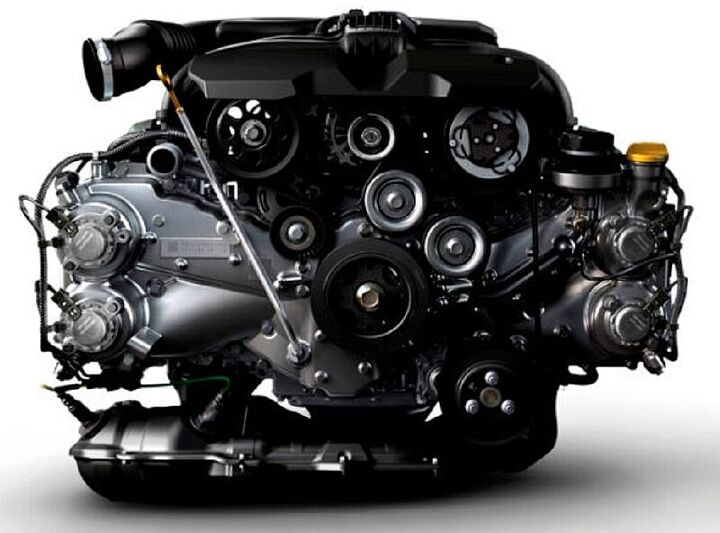Subaru Reinvents The Boxer Engine, Minus The Direct Injection

There it is, Subaru’s all-new gen 3 engine, its first new boxer since 1989, and only the third since 1966 (full history here). As is obvious at first glance, Subaru has reverted to a DOHC head, after switching to a SOHC back in 2000. What’s not so apparent is that the internal architecture is very different: the boxer loses its oversquare (large bore/short stroke) configuration for… the opposite. Long strokes are in (again), favored for their compact combustion chambers and ideal torque curves. The new engine has a host of other goodies, and is expected to be 10% more efficient. But direct injection is not on the list. Nor is piston slap, hopefully.
The New-generation Subaru Boxer engine
The 2011 Forester will be the first recipient of the new motor, which will then spread across the line. Subaru has also announced its intentions for a hybrid version.

More by Paul Niedermeyer
Latest Car Reviews
Read moreLatest Product Reviews
Read moreRecent Comments
- Carson D A friend of mine bought a Cayenne GTS last week. I was amazed how small the back seat is. Did I expect it to offer limousine comfort like a Honda CR-V? I guess not. That it is far more confining and uncomfortable than any 4-door Civic made in the past 18 years was surprising. It reminded me of another friend's Mercedes-Benz CLS550 from a dozen years ago. It seems like a big car, but really it was a 2+2 with the utilitarian appearance of a 4-door sedan. The Cayenne is just an even more utilitarian looking 2+2. I suppose the back seat is bigger than the one in the Porsche my mother drove 30 years ago. The Cayenne's luggage bay is huge, but Porsche's GTs rarely had problems there either.
- Stanley Steamer Oh well, I liked the Legacy. It didn't help that they ruined it's unique style after 2020. It was a classy looking sedan up to that point.
- Jalop1991 https://notthebee.com/article/these-people-wore-stop-signs-to-prank-self-driving-cars-and-this-is-a-trend-i-could-totally-get-behindFull self stopping.
- Lou_BC Summit Racing was wise to pull the parts. It damages their reputation. I've used Summit Racing for Jeep parts that I could not find elsewhere.
- MaintenanceCosts The crossover is now just "the car," part 261.


































Comments
Join the conversation
Any news on a diesel making it to North America? There's Euro diesel version but I have no idea just how series of an effort it is on the part of Subaru.
I see some rather unsubstantiated claims about long stroke engines having better thermodynamic efficiency than short stroke ones. Can anyone cite some proper engineering references as to why this should be so? Because I've never run into any myself. In fact, the opposite claims are usually made. A larger bore allows bigger valves and better breathing, and the total distance for a flame front to travel from a central plug to the extremity of the cylinder is less, because the capacity of the cylinder increases as the square of the bore and only linearly with the stroke. Then. everyone goes on about long stroke engines having better torque. Hmm, like Hondas, you mean, which have a hard time removing the skins from rice puddings at low revs in my experience. Remember that a bigger piston puts more force onto the longer stroke, and there isn't much overall difference, as witness the old and new engines here. The only reason I can think of for the change is to make the pistons much lighter, and to make it easier to have a compact combustion chamber. But each ring will have to move farther and faster in the bore, and each rod big end will encounter more sliding friction on the crank. I'd have to say it's a bit of a wash, but allows the new engine to be more like the diesel casting. I'm open to anyone's referenced arguments as to the merits of a long stroke. But lowered volumetric efficiency with the smaller valves does not equate to higher efficiency, and the thermodynamic efficiency argument I've only read as anecdotes rather than real engineering findings.